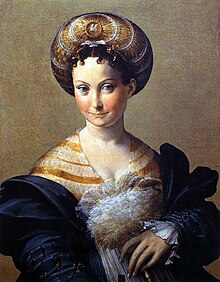The Balzo was a headdress worn by noblewomen of Italy in the 1530s. It was donut-shaped but appeared turban-like from the front, though it was generally worn further back from the forehead exposing the hair, unlike a period turban.

It is assumed as a fashion invention by Isabella d'Este, first documented in letters in 1509 and 1512[2] and well copied in later years.
The headdress was a throwback to a larger rounded headdress from the 15th century in Italy that covered the hair of the wearer.[3] Then the hairline was often plucked. Though mostly known as a woman's headdress, there is evidence that men also wore a form of the balzo.
-
Profile Portrait of a Lady, c.1410 portrait of a woman wearing an "early balzo" with a plucked forehead
-
Francesco Francia attributed - likely Isabella d'Este in 1511
-
Two women and a man wearing a balzo, showing the differences in style
References
edit- ^ 20,000 Years of Fashion, page 219-220
- ^ Luzio and Renier: Il lusso di Isabella d’Este, Marchesa di Mantova: la guardaroba, Nuova antologia, vol. 63 (1896) p. 462 and vol. 64 (1896) p. 667.
- ^ Balzo Archived 2016-09-07 at the Wayback Machine on clothing website
Wikimedia Commons has media related to Balzo.


